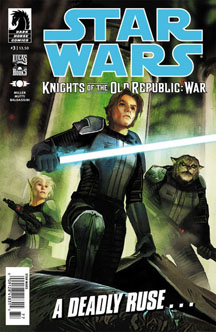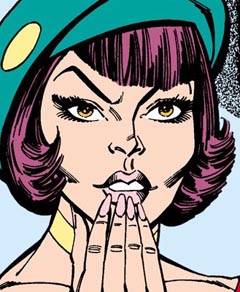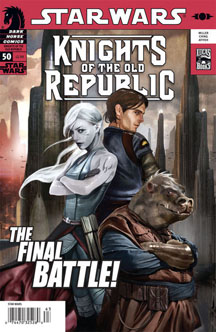John Jackson Miller doles out the answers to long-simmering mysteries fast and furious in the series-concluding “Knights of the Old Republic” Issues 47-50 (2009-10). The author’s meticulous crafting of the plot pays off in this final arc, titled “Demon” (illustrated by Brian Ching), while he still keeps personalities, relationships and funny moments at the fore.
When I started these reviews, I noted “Knights’ ” similarity to “Firefly,” as both stories are about folks of diverse backgrounds who have the common trait of being on the run from something. So I had to laugh when we see giant stone statues of Gryph and Slyssk on Coruscant: “We, uh, saved half a battalion by accident,” when he and Slyssk escaped from Serroco, Gryph explains. Whether Miller was giving a nod to “Jaynestown” or not, it’s a funny moment.
The story of Rohlan Dyre, the mysterious Mandalorian traveling with Zayne’s group, is less comedic. As revealed in more flashbacks, the mad Mando scientist Demagol switched places with Rohlan during the events way back in Issue 10. (The real Rohlan, who recently woke from a long coma in a Republic hospital, is who he says he is: A Mandalorian deserter, “The Questioner,” who had been spying on Demagol and Casssus Fett to try to figure out the reason for the war.)
Then we learn that Demagol was originally the Zeltron Antos Wyrick, father of Chantique, teacher of Jarael and master of the Osadia School that had crooked ties to the Crucible slaver ring. Also, he can use the Force (although, oddly, he’s not aware of it), and it was the masked Mandalorian Demagol, not Jarael, who used the Force to save their hides at the end of Issue 37.
In a nice tie-in to the “Tales of the Jedi” saga, we learn that Wyrick/Demagol created unstable clones from DNA on the cloak of Arcanian Jedi Master Arca Jeth. Among those clones is Jarael. Exar Kun’s lightsaber, one of the Sith artifacts Zayne’s group uncovered back in Issue 30, makes a neat cameo as the weapon that wipes out Demagol and Chantique.
While the Zayne-Jarael kiss that concludes Issue 50 is a giggle-worthy bowtie on the series, we were left with some major unanswered questions: What about Revan and Malak (explored in Issue 42, and featured prominently in the “Knights” video game that chronologically follows the comics)? And would Rohlan ever figure out the Mandos’ reason for invading the Republic?

For a couple years, Miller turned his attention to his “Knight Errant” and “Lost Tribe of the Sith” sagas, but 2012’s five-issue “Knights of the Old Republic: War” seemingly would answer those lingering questions. But it does not. The lackluster art by a team that hadn’t worked on “Knights” before this probably makes me downgrade a decent story from Miller: Suiting up first for the Phaeda militia (the Republic does not create an official army until the prequels, although it kinda sorta has an army in “War” anyway) and then for the Mandalorians (who assimilate prisoners into their army), Zayne desperately tries to minimize killings battle by battle.

Building on Karen Traviss’ work in the “Republic Commando” books, Miller presents a fascinating portrayal of Mando culture, which does not split itself into soldiers and civilians. Indeed, it’s not unusual to see families and children in a war zone. He contrasts this with the Republic, which – one could argue — uses Jedi to do its dirty work, and is therefore less noble than the Mandos.
While we’re told on the first page that the Revanchists (those Jedi who ignored the Jedi Council’s stance of neutrality and fight with the various Republic militias) have helped push back the Mandalorians’ advance, these Revanchists – including Revan himself and Jarael’s sort-of-former-flame Malak – do not appear in “War” at all. Rather, Miller explores a new concept: Mandalorian Knights, Jedi who joined the Mandos because they believe it is the righteous side.
In the end, Zayne sides with the Republic and becomes the “special diplomatic agent” on a Republic frigate as the war goes forward. Throughout this miniseries, I felt the fact that the Republic did not start the war gave them moral high ground when comparing the two sides, but Miller never brings this idea to the fore. In fact, Rohlan, “The Questioner,” isn’t in “War” at all (and Gryph and Jarael only make cameos), and we don’t get so much as a clue as to why the Mandalorians started the war.
We know why the Mandos fight. As Mandalorian Knights leader Dorjander Kace tells Zayne: “On this, the Mandalorians and the Republic agree – strategy isn’t the business of soldiers.” (Presumably, strategy extends to encompass the very rationale of the war, seeing as how Rohlan’s questions were not well received by his higher-ups.) And we can guess why the top military man, Cassus Fett, fights, even though Rohlan’s studies were interrupted: Cassus is most likely a sociopathic murderer.
But we don’t know why the Mandalorians’ overall military/governmental/cultural leader (always given the title Mandalore, although we don’t know anything about this particular Mandalore) has called for a war against the Republic. Perhaps that answer comes in the video game or future stories. Regardless, I wish Miller could’ve found a way to work it into this final “Knights of the Old Republic” story. Because of the unanswered mystery, “War” is something less than fantastic.

